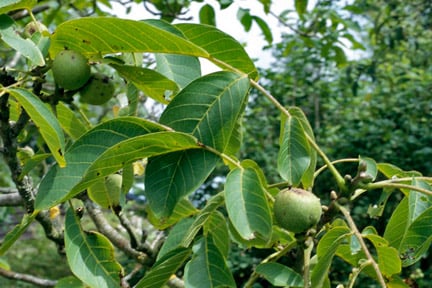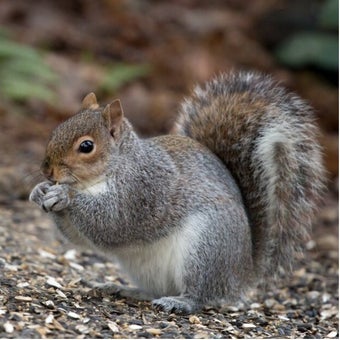
Quick facts
Common name - Walnut, common walnut, English walnut
Botanical name - Juglans regia
Group - Fruiting deciduous tree
Flowering time - Early spring
Planting time - Late autumn to winter
Height and spread - 30m (100ft) 15m (50ft)
Aspect - Full sun, avoiding frost pockets and exposed sites
Hardiness - Fully hardy but fruit set may be reduced by spring frost
Difficulty - Moderate once the tree is established
Cultivation
- Walnuts tolerate most soils, but prefer well-drained, fertile, moisture-retentive, alkaline loam (a soil that is not very clayey or sandy)
- Avoid frost pockets and exposed sites – strong winds and spring frosts can damage foliage and flowers. Likewise, nut crops are unreliable north of the Midlands
- Young trees less than 3m (10ft) tall, are easiest to establish and care must be taken to prevent damage to the tap root, so plants should be avoided
- Light shade is tolerated at the early stages of development but full sun is ideal
- Walnuts may be partially self-fertile – the 'Broadview' for instance – but cropping is improved if cross-pollinated
- Trees planted in autumn or winter establish best and trees should be spaced 12-18m (40-60ft) apart
- Apply a balanced fertiliser such as Growmore, at 100g per sq m (3oz per sq yd) in late February, followed by 35g per sq m (1oz per sq yd) of sulphate of ammonia, in late March. Alternatively, you could use dried poultry manure at 200g per sq m (6oz per sq yd)
- Newly-planted trees need to be staked and watered during dry spells in the spring and summer to encourage good establishment. A of well-rotted around the base of the tree will help to retain moisture
Harvesting and storing
The nuts develop in a pitted shell surrounded by a fibrous, leathery casing which splits when the nuts ripen in autumn. Nuts can be eaten at this stage but tend to have a rubbery texture. Usually it is better to dry them which will also mean they keep well. Dry the nuts as follows;
- Break open a couple of nuts to start with to ensure there is a fully formed kernel inside. If not, do not waste time on the others
- If the nuts are good, remove all traces of the fibrous casing with a wire brush before storage to prevent mould developing
- Gloves should be worn when removing the casings as walnuts stain the skin
- Dry the nuts in a cool oven at no more than 40°C (104°F)
- Once fully dry, store them in a cool dry place
- Harvest nuts daily as they are very vulnerable to birds and squirrels
In cooler areas, the nuts may not fully ripen. These can be pickled at the green stage but before the outer casing begins to toughen.
Harvesting walnuts at the later stage when their outer husks have softened and blackened is not recommended as this can taint the flavour of the inner nut.
Pruning and training
Walnut trees can be grown with a central leader. Alternatively, prune to encourage the production of side shoots by removing the leader - this also restricts the size of the tree. The side shoots should be pinched at the fifth or sixth leaf to encourage the tree to bush. Regular pruning is unnecessary but, if required, remove dead or crossed branches. Pruning should be undertaken between mid-summer and early autumn as walnuts are prone to ' ' ( oozing from the pruning cut). Hard pruning is not tolerated.
Propagation
- Cuttings. Walnuts are difficult to raise from as rooting is poor
- . Named cultivars are propagated by whip grafting or T-budding onto one-year old of Juglans nigra (black walnut) or J. regia (common or English walnut)
- Seed. Fresh seed, from which all the green fibrous husk has been removed, is sown 3cm (1¼in) deep in pots, containing well-drained soil or gritty . In the following August, seedlings should be ready to T using fresh wood or grafts may be made later in the year
Cultivar selection
'Broadview': disease resistant, relatively slow growing and compact habit, producing a heavy crop of good quality, medium sized nuts after three years. Partially self-fertile but crops better if cross-pollinated.
'Buccaneer': disease resistant, fast growing and upright with good quality, medium sized nuts by a lighter crop than 'Broadview'. Self-fertile and bears after four years
'Lara': disease resistant, newer with heavy crop of large nuts on a moderately vigorous tree
Links
Problems
Walnuts are largely pest and disease free but may suffer from the following;
- Grey squirrels can devastate the entire crop. Wrapping the trunk with plastic tree guard that squirrels cannot grip and raising the lower branches to 1.8-2.5m (6-8ft) can deter attack
- Walnut leaf gall causes pouch-shaped galls on the leaves but they are insignificant
- Walnut leaf blotch and anthracnose can affect the leaves. There is no chemical control for these diseases but collection and disposal of the diseased leaves can break the life cycle of the infection
- Codling moth may damage nuts
Allelopathy
Walnuts secrete chemicals into the soil which inhibit other plants. This is known as allelopathy. However, the effect is more discernable from Juglans nigra (black walnut) than J. regia (common or English walnut). Tomatoes and apples are said to be especially affected.

